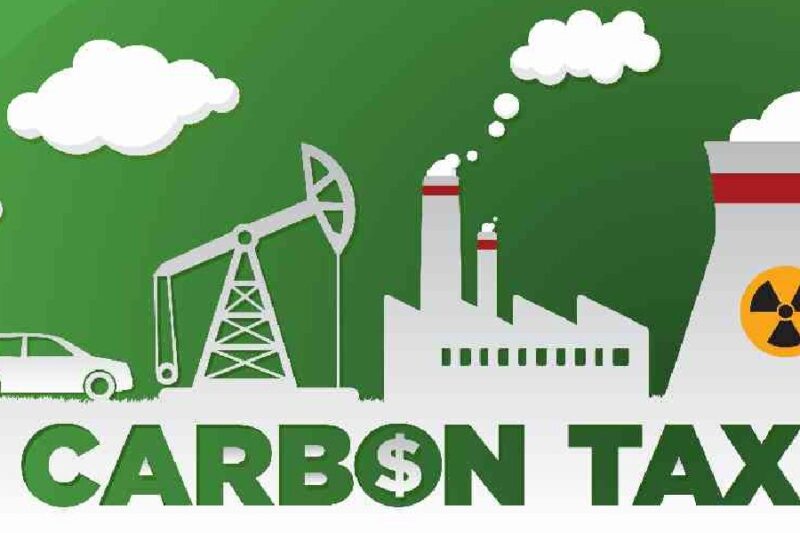In recent years, the concept of a carbon tax has gained significant attention and has become a hot topic in environmental policy discussions. But what exactly is a carbon tax? And how can it help in the fight against climate change?
What is a Carbon Tax?
A carbon tax is a tax imposed on the carbon content of fossil fuels. It is a type of carbon pricing that aims to reduce greenhouse gas emissions by making fossil fuels more expensive. The idea is that the higher cost will incentivize businesses and consumers to reduce their carbon emissions by using cleaner energy sources.
How Does a Carbon Tax Work?
The basic principle behind a carbon tax is to put a price on carbon to incentivize emitters to reduce their greenhouse gas emissions. The tax is usually levied on the carbon content of fossil fuels, such as coal, oil, and natural gas. The revenue generated from the tax can be used for various purposes, such as funding renewable energy projects, improving energy efficiency, or returning the money to the public through dividends or tax credits.
Types of Carbon Taxes
There are different ways to implement a carbon tax, and the design can vary depending on the goals and the specific circumstances of the region or country. Some common types of carbon taxes include upstream taxes, which are levied on the production or import of fossil fuels, and downstream taxes, which are levied on the consumption of fossil fuels.
Advantages of a Carbon Tax
There are several advantages to implementing a carbon tax. One of the main benefits is that it provides a clear price signal to businesses and consumers, encouraging them to reduce their carbon emissions. Additionally, a carbon tax can generate significant revenue that can be used to fund renewable energy projects or to provide rebates or tax credits to low-income households.
Disadvantages of a Carbon Tax
Despite its potential benefits, a carbon tax also has some drawbacks. One of the main criticisms is that it can disproportionately impact low-income households, as they often spend a larger proportion of their income on energy. Additionally, there are concerns that a carbon tax could lead to job losses in industries that are heavily reliant on fossil fuels.
Global Examples of Carbon Taxes
There are several countries around the world that have implemented a carbon tax, and the results have been mixed. In Sweden, for example, a carbon tax has been in place since 1991 and has been credited with reducing the country’s greenhouse gas emissions by 25%. However, in Australia, a carbon tax was repealed after just two years due to political opposition and concerns about its impact on the economy.
Carbon Tax in the United States
In the United States, there is currently no federal carbon tax, but there have been several proposals to introduce one. Some states, such as California and Massachusetts, have implemented their own carbon pricing systems, and there are ongoing discussions at the federal level about the potential benefits and drawbacks of a national carbon tax.
Arguments for a Carbon Tax
Proponents of a carbon tax argue that it is a necessary and effective tool for reducing greenhouse gas emissions and combating climate change. They point to the success of carbon taxes in other countries, such as Sweden, and argue that a carbon tax can provide a clear price signal that encourages businesses and consumers to reduce their carbon emissions.
Arguments Against a Carbon Tax
Opponents of a carbon tax argue that it is an unnecessary and harmful tax that will lead to job losses and economic hardship. They also argue that a carbon tax is regressive and will disproportionately impact low-income households. Additionally, some critics argue that a carbon tax is not the most effective way to reduce carbon emissions and that other policies, such as regulations and subsidies for renewable energy, are more effective.
The Role of Citizens
Citizens play a crucial role in the success or failure of a carbon tax. Public support or opposition can influence the political feasibility of a carbon tax, and citizens can also influence the design and implementation of the tax through their advocacy and engagement.
The Role of Corporations
Corporations also play a key role in the carbon tax debate. Many businesses are already taking steps to reduce their carbon emissions and are advocating for a carbon tax as a way to level the playing field and provide a clear price signal for carbon emissions.
The Role of Governments
Governments are responsible for designing and implementing a carbon tax, and they must carefully consider the potential benefits and drawbacks of the tax. This includes balancing the need to reduce carbon emissions with the potential economic and social impacts of the tax.
Conclusion
A carbon tax is a powerful tool that can help reduce greenhouse gas emissions and combat climate change. However, it is not without its challenges and criticisms. It is important for citizens, businesses, and governments to carefully consider the potential benefits and drawbacks of a carbon tax and to work together to design and implement a policy that is fair, effective, and politically feasible.
Similar Articles
- Carbon Credits: A Comprehensive Guide to Offset Emissions
- Carbon Insetting: A Comprehensive Guide
- Carbon-Neutral Journeys: Paving the Way Towards a Sustainable Future
FAQs about Carbon Tax:
1. What is a Carbon Tax?
A Carbon Tax is a tax imposed on the carbon content of fossil fuels. It aims to reduce greenhouse gas emissions by making fossil fuels more expensive, thus incentivizing businesses and consumers to shift to cleaner energy sources.
2. How does a Carbon Tax work?
A Carbon Tax works by putting a price on carbon to incentivize emitters to reduce their greenhouse gas emissions. It is usually levied on the carbon content of fossil fuels such as coal, oil, and natural gas. The revenue generated from the tax can be used for various purposes, such as funding renewable energy projects, improving energy efficiency, or returning the money to the public through dividends or tax credits.
3. What are the advantages of a Carbon Tax?
A Carbon Tax provides a clear price signal that encourages businesses and consumers to reduce their carbon emissions. It can generate significant revenue that can be used to fund renewable energy projects or provide financial support to low-income households. Additionally, it can help drive innovation in clean energy technologies.
4. What are the disadvantages of a Carbon Tax?
One of the main criticisms of a Carbon Tax is that it can disproportionately impact low-income households, who often spend a larger proportion of their income on energy. There are also concerns that it could lead to job losses in industries that are heavily reliant on fossil fuels. Additionally, the effectiveness of a Carbon Tax depends on the specific design and implementation.
5. Are there any examples of countries that have successfully implemented a Carbon Tax?
Yes, there are several countries that have successfully implemented a Carbon Tax, including Sweden, British Columbia (Canada), and Switzerland. In Sweden, the Carbon Tax has been credited with reducing the country’s greenhouse gas emissions by 25%. In British Columbia, the tax has led to a reduction in fuel consumption and an increase in clean energy investments.
6. What is the current status of a Carbon Tax in the United States?
Currently, there is no federal Carbon Tax in the United States. However, some states, such as California and Massachusetts, have implemented their own carbon pricing systems. There have been several proposals for a national Carbon Tax, but they have not been successful so far.
7. How is the revenue from a Carbon Tax used?
The revenue from a Carbon Tax can be used for various purposes, depending on the design and goals of the tax. Some common uses include funding renewable energy projects, improving energy efficiency, providing rebates or tax credits to low-income households, and investing in public infrastructure and transportation.
8. Can a Carbon Tax really help combat climate change?
Yes, a Carbon Tax can be an effective tool for reducing greenhouse gas emissions and combating climate change. By putting a price on carbon, it provides a clear incentive for businesses and consumers to reduce their carbon emissions. However, a Carbon Tax alone is not enough to solve the climate crisis, and it needs to be part of a comprehensive approach that includes other policies and measures.
9. Is a Carbon Tax regressive?
A Carbon Tax can be regressive, meaning it disproportionately impacts low-income households, who often spend a larger proportion of their income on energy. However, this can be addressed through the design and implementation of the tax, such as by using the revenue to provide rebates or tax credits to low-income households, or by investing in programs that benefit these communities.
10. What are some of the challenges in implementing a Carbon Tax?
Some of the challenges in implementing a Carbon Tax include political opposition, concerns about the economic impact and job losses, and the need to balance the need to reduce carbon emissions with the potential social and economic impacts. Additionally, the effectiveness of a Carbon Tax depends on the specific design and implementation, and it needs to be part of a comprehensive approach that includes other policies and measures.










